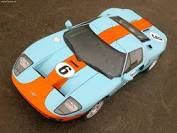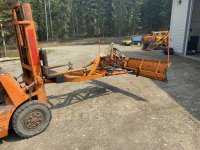Snowy Rivers
Well-known member
Oh yesssssss.Thanks for the replies and pics....
Our objective is a nice, clean repair that's essentially undetectable. I think that’s what both Rob Miller and YDPC were after as well. I have seen some Tuckers listed for sale that have had the same issue, and the “repaired” grousers had the tombstones very roughly hacked out - and not welded back in after the broken bolt was replaced. They looked horrible, and one couldn’t help but look at that level of “workmanship”… and extrapolate it to the rest of the snowcat. At that point I lost all interest in buying the machine.
What we decided to do was along the lines of YDPC’s method. We take an angle grinder and cutoff wheel, and make a vertical cut in the grouser’s supporting angle plate, just inside of where the bolt is. Then another cut along the grouser’s face that intersects that supporting angle plate. Next, we pry the cut section of the angle plate back to expose the welded bolt head. At that point Scott uses his acetylene torch to remove the welded portions of the bolt head. Then it’s driving the broken bolt out, inserting a new bolt, welding the bolt head to the grouser. What’s left to do now is bend the free end of the supporting plate back into position and weld up all the cuts. A little weld cleanup with an angle grinder and it’s done. For increased strength and weld penetration, Scott used his stick welder for all the grouser welding. I thought it was going to be more of a process than it turned out to be. It actually went considerably faster than I expected it to. When does that ever happen?
Pics:
The cut and bent angle supporting plate with the broken bolt removed.
View attachment 163721
New bolt welded in position with the cuts welded.
View attachment 163722
The repaired grouser.
View attachment 163723
YDPC,
I’ve seen a few Tuckers with a two-belt vs four-belt setup. A number of years ago I wondered about that in terms of pros and cons and I was told a big reason for the four-belt setup is that it has better side hill holding ability. Just an FYI… I don’t know if that’s true, or how much of a difference it makes.
Snowy,
Your point about safety glasses hit home. Half a lifetime ago I had a job running a turret lathe and one day I was making a part that had a tapped hole in the end. The tap broke and part of it came up and shattered the left lens of the safety glasses I was wearing. There is zero doubt that without the safety glasses I would have lost the eye. Over the years since, I’ve thought about that, and wondered how different my life would have been had I not been wearing safety glasses. After returning to college and graduating, I went into the USAF for about 8 1/2 years, and that led to a career in aviation. Neither would have been possible….
Having worn glasses since I was about 20 YO they have saved my eyes many times.
I worked in several machine shops over the years running lathes, mills, radial arm drill presses and on and on......
Safety glasses were not necessarily required back in the day....Always recommended but the rule was not enforced much...
I have been hit by flying chips while walking by large milling machines and hot sparks from carbon arc scarfing and on it goes.
I proudly wear the scars of a lot of different incidents.....But still have both eyes and all of my fingers....
You work in industry and or around machining, welding and fabrication CHIT HAPPENS.......It is always there and can get you any time.....
Having good eyesight is a blessing....But having to wear prescription glasses was not a bad thing.....Good quality lenses that can also act as protection and is a good thing.
Drills shatter, taps shatter......Red hot chips fly off the mill/lathe cutter and are always a serious hazard.......
Using a simple tool like a hammer......Swat a punch and a piece of metal flies up and bingo.....A gotcha.....
I was digging a broken tap out of a part years ago.....Tap shattered and a piece the size of a BB flew off and went between the nose piece and the upper bar of my glasses.....Stuck into the bridge of my nose.
I thought it had just nicked me.....Left a little knot that was there for years.
Finally got tired of it being sore from time to time.....Had the Doc look at it.....He dug it out.....Damned chuck of tap....
Had this been an eye.....Game over.........
Safety gear is a good thing.
Another item that sooooo many folks do not think about......"Mechanics gloves" YESSSSSSSSSSS....The amount of chemicals that we can get into such as Gasoline, solvents, antifreeze, greases, oils And much more can all penetrate the skin and in small amounts get into our bodies.
I pretty much use the mechanics gloves when working with these things.....Aside from keeping your paws clean....They help stop the harmful affects of the various chemicals.
After having a kidney removed back in 2013 (April 1st 2013) due to a huge azz tumor) I have way more thought to this stuff.
Another batch of materials are paint supplies, thinners and other nasty stuff...
Many guys seems to think it's only the sissy with well manicured nails and prissy skin use these.....The stuff that can hurt us is a vast amount of stuff.....
Absorption through the skin is real.......And the kidneys are in charge of clearing that crap out......After you lose one to cancer.....YOU THINK ABOUT IT MORE
Grinding off (Sanding) old paint is another nasty job......This stuff goes into your lungs and can do harm.
Good dust protection masks are a good thing.
Painting....especially with multi part paints requires a good respirator system.....
I will not touch that stuff without fresh air mask and a full protective suit.
I am sensitive to the chemicals in it and even a bit on my skin is an emergency......
We use so many things in our cat hobby that can hurt of kill us if we are lax in using protection.
Am I scared....Not even.....I use the protection required.
Just my 2 Cents worth...



